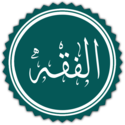Turbah
| Part ofa serieson |
| Islamic jurisprudence (fiqh) |
|---|
 |
| Islamic studies |
Aturbah(Arabic:تربة,lit. 'soil'), ormohr(Persian:مهر,lit. 'seal'), also known askhāk-e shefā(Persian:خاکِ شِفا,lit. 'medicinal soil', also used inUrdu) andsejde gāh(Persian:سجدہ گاہ,lit. 'place of prostration', also used in Urdu), is a small piece of soil or clay, often a clay tablet, used duringsalat(Islamic daily prayers) to symbolizeearth.[1]The use of aturbahisrecommended(mustahabb) according to theTwelver ShiaschoolofIslam,a unique practice of the sect, and manyHadithsmention the benefits of prostration (Sajda) upon soil or an alternative natural material. The most favoured soil is that ofKarbala,the site of the martyrdom ofHusayn ibn Ali;however, soil from anywhere may be used. In the absence of soil, plants or items made from these may be substituted. This provision has been extended to include paper.[2]
Following instruction from theQur’an,ShiaImamJa'far al-Sadiqstated that "prostration must be performed on pure earth or what grows on it, provided that it is not eaten or worn." For example, prostration on paper is permissible because it is made of natural elements grown on earth.[3]
Muhammad and the use of the turbah[edit]
According toAbu Sa`id al-Khudri:“I sawAllah’s Apostle prostrating in mud and water and saw the mark of mud on his forehead.”[4]ThoughMuhammadprayed on the ground, thehadithSahih al-Bukharistates that "Allah’s Apostle used to pray onKhumra."[citation needed]
The idea of "absolute consideration" states that some kinds of soil, and thus some kinds of places, are better than others for prayer. For example, places, buildings, and structures related to Allah and Muhammad are held in the highest regard when it comes to places in which to hold prayer.[5]
Significance of Karbala[edit]

Karbalais especially important to Shi’a Muslims because the martyrdom ofHusayn ibn Aliis considered one of the major dividing lines between Muslims of the time. Husayn is important because of his relationship with Muhammad, and so the dust from Karbala is considered sacred.
To bring this revered material to others worldwide, Shi’a Muslims have made small tablets calledmohrorturbahfrom the earth of Karbala. However, since it is an issue of honor and respect, Muslims are allowed to prostrate on other earthen materials.[6]
Significance and symbolism[edit]
Turbahhas a primary meaning of 'dirt', 'earth' or 'soil', identified as the material Allah used tocreate the earth and humankind.Turbahalso denotes any ground on which one prostrates oneself for prayer. Clean dirt or dust can be a substitute for someone who is performingablutionsin the absence of clean water, a practice known astayammum.
Turbahis also found in the context of funerals because of death's association with dust, as a dead body returns to earth.Turba(ortürbein Turkish) is an Islamic funerary building in a variety of contexts.[7]
Sunni views[edit]
ManySunnisreject the use ofturbahasbid’ah( “innovation” ), noting that according to them, neither Muhammad nor his companions ever carried a clay tablet or similar item on which to place their foreheads while in prostration. They also note that manyturbahused by Shi’a have inscribed invocations to their revered figures, such as 'Ya Hussein' (O Hussein), or 'YaZahra' which may be seen by them as the sin ofShirk(associating partners with God). InMajmoo' al-Fatawa(Compilation ofFatwas),Ibn Taymiyyah,issued a fatwa that prayer on aturbahfrom the site ofImam Husayn's martyrdom (Karbala) is an innovation.[8]
As a result, theturbahis highly stigmatized or even banned in mostMuslim majority countriesoutside predominantly Shiite Iran and Iraq.
See also[edit]
- Prayer callus,result of a similar practice done by Sunni Muslims inEgypt
References[edit]
- ^Orr, Francine (26 November 2001). "Sharing the Faith, Spreading the Word".Los Angeles Times.pp. E2.
- ^Fontan, Victoria (2008).Voices from post-Saddam Iraq: living with terrorism, insurgency, and new forms of tyranny.ABC-CLIO. p. 42.ISBN978-0-313-36532-4.
- ^Ahlul Bayt Digital Islamic Library Project. "In A Nutshell: Laws and Practices." 1 April 2010. < al-islam.org>.
- ^Al-Bukhari, Sahih (English translation), vol 1, book 12, no. 798; vol. 3, book 33, no. 244
- ^al-Jibouri, Yasin T."Why Prostrate on Karbala's Turba".Ahlul Bayt Digital Islamic Library Project.Retrieved12 April2010.
- ^Ahlul Bayt Digital Islamic Library Project. In A Nutshell: Laws and Practices. Ahlul Bayt Digital Islamic Library Project Team. Web. 1 Apr. 2010. < al-islam.org>.
- ^Leisten, T. (2010)."Turba".In P. Bearman; T Bianquis; C.E. Bosworth; E. van Donzel; W.P. Heinrichs (eds.).Encyclopaedia of Islam(Second ed.). Brill.Retrieved18 March2010.
- ^Ibn Taymiyyah.Majmoo' al-Fatawa.Vol. 22. p. 163.
.... And it was asked from him about the prostration on a Turbah Al-Husseinya in the mosque and prayer (performing of Salat) on it: Is it an act of Innovation (Bid'ah) or not? So he replied positively: 'Praise be to the Lord of the Worlds, as for the Salat on the Turbah Al-Husseinya on which the Salat performer prays, that is not from the Sunnah of theSalafofMuhajirunorAnsarand nor from the Sunnah ofTabieenafter them; on whom is the blessing/favor of Allah on the promise of the Prophet Muhammad. But in fact all of these people prayed in the mosque on normal soil. Not even one of them ever took a Turbah Al-Husseinya to pray on for their Salat.'

